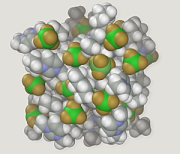Related Research Articles
Quantum chemistry, also called molecular quantum mechanics, is a branch of physical chemistry focused on the application of quantum mechanics to chemical systems, particularly towards the quantum-mechanical calculation of electronic contributions to physical and chemical properties of molecules, materials, and solutions at the atomic level. These calculations include systematically applied approximations intended to make calculations computationally feasible while still capturing as much information about important contributions to the computed wave functions as well as to observable properties such as structures, spectra, and thermodynamic properties. Quantum chemistry is also concerned with the computation of quantum effects on molecular dynamics and chemical kinetics.
Q-Chem is a general-purpose electronic structure package featuring a variety of established and new methods implemented using innovative algorithms that enable fast calculations of large systems on various computer architectures, from laptops and regular lab workstations to midsize clusters, HPCC, and cloud computing using density functional and wave-function based approaches. It offers an integrated graphical interface and input generator; a large selection of functionals and correlation methods, including methods for electronically excited states and open-shell systems; solvation models; and wave-function analysis tools. In addition to serving the computational chemistry community, Q-Chem also provides a versatile code development platform.

Ghemical is a computational chemistry software package written in C++ and released under the GNU General Public License. The program has graphical user interface based on GTK+2 and supports quantum mechanical and molecular mechanic models, with geometry optimization, molecular dynamics, and a large set of visualization tools. Ghemical relies on external code to provide the quantum-mechanical calculations — MOPAC provides the semi-empirical MNDO, MINDO, AM1, and PM3 methods, and MPQC methods based on Hartree–Fock calculations.

Corannulene is a polycyclic aromatic hydrocarbon with chemical formula C20H10. The molecule consists of a cyclopentane ring fused with 5 benzene rings, so another name for it is [5]circulene. It is of scientific interest because it is a geodesic polyarene and can be considered a fragment of buckminsterfullerene. Due to this connection and also its bowl shape, corannulene is also known as a buckybowl. Buckybowls are fragments of buckyballs. Corannulene exhibits a bowl-to-bowl inversion with an inversion barrier of 10.2 kcal/mol (42.7 kJ/mol) at −64 °C.

PQS is a general purpose quantum chemistry program. Its roots go back to the first ab initio gradient program developed in Professor Peter Pulay's group but now it is developed and distributed commercially by Parallel Quantum Solutions. There is a reduction in cost for academic users and a site license. Its strong points are geometry optimization, NMR chemical shift calculations, and large MP2 calculations, and high parallel efficiency on computing clusters. It includes many other capabilities including Density functional theory, the semiempirical methods, MINDO/3, MNDO, AM1 and PM3, Molecular mechanics using the SYBYL 5.0 Force Field, the quantum mechanics/molecular mechanics mixed method using the ONIOM method, natural bond orbital (NBO) analysis and COSMO solvation models. Recently, a highly efficient parallel CCSD(T) code for closed shell systems has been developed. This code includes many other post Hartree–Fock methods: MP2, MP3, MP4, CISD, CEPA, QCISD and so on.
General Atomic and Molecular Electronic Structure System (GAMESS (US)) is computer software for computational chemistry. The original code started on October 1, 1977 as a National Resources for Computations in Chemistry project. In 1981, the code base split into GAMESS (US) and GAMESS (UK) variants, which now differ significantly. GAMESS (US) is maintained by the members of the Gordon Research Group at Iowa State University. GAMESS (US) source code is available as source-available freeware, but is not open-source software, due to license restrictions.
General Atomic and Molecular Electronic Structure System (GAMESS-UK) is a computer software program for computational chemistry. The original code split in 1981 into GAMESS-UK and GAMESS (US) variants, which now differ significantly. Many of the early developments in the UK version arose from the earlier UK based ATMOL program, which, unlike GAMESS, lacked analytical gradients for geometry optimisation.
The fragment molecular orbital method (FMO) is a computational method that can be used to calculate very large molecular systems with thousands of atoms using ab initio quantum-chemical wave functions.
Firefly, formerly named PC GAMESS, is an ab initio computational chemistry program for Intel-compatible x86, x86-64 processors based on GAMESS (US) sources. However, it has been mostly rewritten, especially in platform-specific parts, mathematic functions, and quantum chemistry methods. Thus, it is significantly faster than the original GAMESS. The main maintainer of the program was Alex Granovsky. Since October 2008, the project is no longer associated with GAMESS (US) and the Firefly rename occurred. Until October 17, 2009, both names could be used, but thereafter, the package should be referred to as Firefly exclusively.
The polarizable continuum model (PCM) is a commonly used method in computational chemistry to model solvation effects. If it is necessary to consider each solvent molecule as a separate molecule, the computational cost of modeling a solvent-mediated chemical reaction would grow prohibitively high. Modeling the solvent as a polarizable continuum, rather than individual molecules, makes ab initio computation feasible. Two types of PCMs have been popularly used: the dielectric PCM (D-PCM) in which the continuum is polarizable and the conductor-like PCM (C-PCM) in which the continuum is conductor-like similar to COSMO Solvation Model.

Molecular modeling on GPU is the technique of using a graphics processing unit (GPU) for molecular simulations.
Angela K. Wilson is an American scientist and former (2022) President of the American Chemical Society. She currently serves as the John A. Hannah Distinguished Professor of Chemistry, associate dean for strategic initiatives in the College of Natural Sciences, and director of the MSU Center for Quantum Computing, Science, and Engineering (MSU-Q) at Michigan State University.
TeraChem is a computational chemistry software program designed for CUDA-enabled Nvidia GPUs. The initial development started at the University of Illinois at Urbana-Champaign and was subsequently commercialized. It is currently distributed by PetaChem, LLC, located in Silicon Valley. As of 2020, the software package is still under active development.
Michael Bühl is a professor of Computational and Theoretical Chemistry in the School of Chemistry, University of St. Andrews. He has published work on the performance of various density functionals, modelling thermal and medium effects, transition-metal NMR of metalloenzymes, modelling of homogeneous catalysis, and molecular dynamics of transition metal complexes.
Erin Johnson is a Canadian computational chemist. She holds the Herzberg–Becke Chair at Dalhousie University. She works on density functional theory and intermolecular interactions.
Peter Grootenhuis was a Dutch-American Medicinal Chemist. Grootenhuis was the Project Leader and Co-Inventor of Ivacaftor (VX-770), the first CFTR potentiator FDA approved drug to treat the underlying cause of Cystic Fibrosis (CF) in patients with certain mutations in the Cystic Fibrosis Transmembrane Conductance Regulator (CFTR) gene, who account for 4-5% of CF cases. Grootenhuis also led the Vertex team to subsequent discovery of Orkambi, the combination of Ivacaftor and Lumacaftor(VX-809), approved to treat CF in people with two copies of the F508del mutation. Most recently, Grootenhuis's team discovered Tezacaftor (VX-661) and Elexacaftor (VX-445), which in combination with Ivacaftor are the components of Trikafta, a drug approved by the FDA in 2019 to treat CF in more than 90% of CF patients. For Grootenhuis’ contributions to the discovery of these compounds, he was awarded the 2018 IUPAC Richter Prize, the American Chemical Society’s 2013 Heroes of Chemistry Award, and inducted into the American Chemical Society Division of Medicinal Chemistry Hall of Fame. Grootenhuis has contributed to the discovery of over 11 clinical candidates, co-authored more than 100 peer reviewed papers and is inventor of 65 + U.S Patents, and more than 50 EU Patents.
Theresa Lynn Windus is an American chemist who is a distinguished professor at Iowa State University and the Ames Laboratory. Her research involves the development and use of high performance computational chemistry methods to tackle environmental challenges, including the development of new catalysts and renewable energy sources. She was elected a Fellow of the American Chemical Society in 2020.
Kieron Burke is a professor known for his work in the field of quantum mechanics, particularly in developing and advancing density functional theory (DFT). He holds joint appointments as a distinguished professor in the Departments of Chemistry and Physics at the University of California, Irvine (UCI).
References
- 1 2 "Tianjin University scientist awarded by IUPAC". China Daily. March 27, 2019. Archived from the original on September 5, 2019.
- 1 2 3 "MSU Academic Hall of Fame honors Kim Baldridge" (PDF). Public Information Office Newsletter. Minot State University. September 25, 2013. Archived from the original (PDF) on September 6, 2015.
- ↑ "Kim Baldridge". Tianjin University School of Pharmaceutical Science and Technology. Retrieved May 29, 2024.
- ↑ "SDSC Chemist Awarded Visiting Professorships for Women Grant by the NSF". San Diego Supercomputer Center. October 30, 1995. Retrieved 2020-10-27.
- 1 2 Howell, Brett; McDonald, Kim (May 16, 2001). "UCSD Professors in the Biology and Physical Sciences Divisions Honored for Achievements". University of California, San Diego . Retrieved 2020-10-27.
- ↑ Rouhi, Maureen A. (February 3, 2004). "Zurich Pulls in Chemical Talent". C&EN News . Retrieved May 29, 2024.
- ↑ Tremblay, Jean-François (October 23, 2013). "American Takes Charge In Tianjin". Chemical & Engineering News. Vol. 91, no. 43.
- ↑ Baldridge, Kim K.; Gordon, Mark S.; Steckler, Rozeanne; Truhlar, Donald G. (1989). "Ab initio reaction paths and direct dynamics calculations". J. Phys. Chem. 93 (13): 5107–5119. doi:10.1021/j100350a018.
- ↑ Baldridge, Kim; Klamt, Andreas (1997). "First principles implementation of solvent effects without outlying charge error". J. Chem. Phys. 106 (16): 6622–6633. Bibcode:1997JChPh.106.6622B. doi:10.1063/1.473662.
- ↑ Peverati, Roberto; Baldridge, Kim K (2008). "Implementation and Performance of DFT-D with Respect to Basis Set and Functional for Study of Dispersion Interactions in Nanoscale Aromatic Hydrocarbons". J. Chem. Theory Comput. 4 (12): 2030–2048. doi:10.1021/ct800252z. PMID 26620476.
- ↑ Schmidt, Michael W.; Baldridge, Kim K.; Boatz, Jerry A.; Elbert, Steven T.; Gordon, Mark S.; Jensen, Jan H.; Koseki, Shiro; Matsunaga, Nikita; Nguyen, Kiet A.; Su, Shujun; Windus, Theresa L.; Dupuis, Michel; Montgomery Jr, John A. (1993). "General atomic and molecular electronic structure system". Journal of Computational Chemistry . 14 (11): 1347–1363. doi:10.1002/jcc.540141112.
- ↑ "Roster of Fellows for 2001" (PDF). www.aaas.org. Retrieved May 30, 2024.
- ↑ "Awardees of the IUPAC 2019 Distinguished Women in Chemistry or Chemical Engineering". iupac.org. February 7, 2019. Retrieved May 29, 2024.